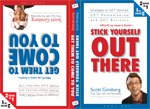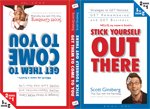 I’m not an angry person.
I’m not an angry person.
My feathers err on the side of unruffleable.
But I am human. I do get emotional. And if there’s one thing that makes me want to slowly rip each of my toenails off with a needle nose pliers dipped in sulfuric acid, it’s people who spend their time flapping their gums instead of shuffling their feet.
To coin a phrase: The executionally deficient.
But instead of resorting self-mutilation (again), I’ve decided to channel my frustration into something a bit more productive.
Here’s a helpful list of seven reasons why you’re (not) turning your ideas into realities.
1. You’re too busy networking. Attending lunches, conference and coffee meetings is a great way to meet people – but it’s also a great way to avoid work. My suggestion: Stop playing dress up and go create something. Stop schmoozing and start shipping.
Not that face time isn’t valuable. Just don’t overlook the importance of workbench time.
Also, be careful not to get sucked into the vortex of online connecting.
Social media is great for guzzling your time, feeding your ego, finding mindless entertainment, causing additional stress in your life that you don’t need, helping you contribute more unoriginal thinking to the echo chamber, and allowing you to participate in (yet another) online pissing contest.
But when it comes to execution, social media is largely a distraction. Choose wisely. Are you too busy connecting with people who don’t matter to execute stuff that does matter?
2. You’re talking your ideas into the ground. There is an inverse relationship between the number of people you tell about your exciting new idea and the number of days before that idea (actually) comes to fruition. Julia Cameron outlined this concept in The Artist’s Way:
“The first rule of magic is self-containment. You must hold your intention within yourself, stoking it with power. Only then will you be able to manifest what you desire.”
Hey: I’m all for sharing your goals with the world. And memorializing your intentions. And bringing your dreams to fruition through visualization and peer accountability. I also think it’s easy to blow lid off your ideas by telling too many people about them. Will your lack of self-control slowly dissipate your idea into the quicksand of non-execution?
3. You’re dissipating yourself in useless activity. It’s amazing: People always seem to make time for what’s (not) important to them. My suggestion: Stop saying yes to everything. Learn to be discerning. (Not snobby, but discerning). Create an opportunity filter if you have to.
Otherwise your agenda will collapse too easily and you’ll never execute anything that counts.
Remember: If you don’t set boundaries for yourself, other people will set them for you. And then they will violate them. And then they will tell all their little friends to the same. All because you never set a precedent of value on your time. Are you a businessperson or a professional volunteer?
4. You’re trying to do everything yourself. Which means you’re a perfectionist. Which means you’re a control freak. Which means you’ve never going to declare anything done. Which means you’re never going to be fully sated.
For example, my friend Mara is currently redesigning her blog. When she sent me a ten-page document of comps, pictures and sketches – which looked awful, by the way – I asked her one question: “Mara, are you a blog designer?” As suspected, she replied, “No.” At which point I suggested, “Then you need to pay someone who is.”
Lesson learned: Next time you find yourself trapped in control-freak mode, simply ask yourself the same question: Is this what I do for living? If the answer is no, pay someone who does do it for a living while you go do something that matters.
Learn to surrender control of your ideas and let the pros do what they do. Learn to trust smart people. Execution will happen faster, better and cheaper. How much money is one hour of your time worth?
5. You’re not willing to pay the (financial) price. People come to me for help all the time. Some are entrepreneurs. Some are business owners. Some are corporate workers. Some are single parents. Either way, I’m happy to advise. For a fee, that is. Notice my one-on-one department is called Rent Scott’s Brain, not Waste Scott’s Time.
Interestingly, the minute I put a stake in the ground and set a precedent of value on my availability, people flinch. They back off. And they always feed me the same, stock excuse: “Well, it’s not that I don’t think you’re worth the money, it’s just that…”
Wrong. It has nothing to do with me, and everything to do with your unwillingness to commit with both feet. That’s exactly why I charge for my time: Because people who don’t pay me don’t hear me. I charge enough so people will actually listen to – and take action upon – what I say. And with financial investment comes greater commitment to execution. Every time. Who have you hired lately?
6. You’re placing too many cumbersome demands on yourself. I’m all for diversification. Pursuing multiple projects simultaneously is usually a smart move. But having too many irons in the fire does nothing but slowly melt your ability to execute into a steaming puddle of silver goo. Terminator 2 style.
The problem is, you’re your own worst enemy in creating chaos in your life. You have to be willing to hang up your Superman cape and ask yourself, “Where (and why) am I constantly trying to impress myself?” Remember: The dog who chases two rabbits doesn’t just go hungry – he looks stupid while starving.” Are you a victim of your own lack of focus?
7. You’re spending most of your time whining about the progress you’re not making. Sadly, this is a popular (but poor) energy investment decision made by entrepreneurs. It reminds me of an old Calvin & Hobbes comic I read as a kid. For some reason, this particular strip always stuck with me.
During a parent/teacher conference, Mrs. Wormwood explains to Calvin’s mother, “If he put half as much energy into his work as he did into his protests, he might actually score well.” Do you know someone like this? Work with someone like this? Marry someone like this?
It’s amazing: If people sat down and actually mapped out their energy investments, they’d be astonished at how out of whack their priorities were. My suggestion: Don’t let this happen to you. Beware of investing your finest energies running in place. Treadmills are great for a convenient workout, but the scenery never changes and your knees always end up hurting like hell.
Remember: If you’re wasting all your time externalizing the reasons for a lack of progress, you’ll never actually make any. Learn to greet obstacles as exciting challenges that you can creatively attack. Do you complain about the wind, hope the wind will stop, or adjust your sails?
REMEMBER: Failure isn’t due to a lack of ideas – it’s due to a lack of implementation.
I challenge you to plug yourself into these seven execution equations.
You’ll have those feet shuffling in no time.
LET ME ASK YA THIS…
How are you closing the execution gap?
LET ME SUGGEST THIS…
For the list called,”11 Ways to Out Market the Competition,” send an email to me, and you win the list for free!
* * * *
Scott Ginsberg
That Guy with the Nametag
Author, Speaker, Coach, Entrepreneur
[email protected]
 Never the same speech twice.
Never the same speech twice.
Always about approachability.
Watch The Nametag Guy in action here!

 Life isn’t fair.
Life isn’t fair. Anybody can start.
Anybody can start. Marry Poppins was an entrepreneur.
Marry Poppins was an entrepreneur. Thank God for country music.
Thank God for country music.  “Wow, you sure know how to make a point!”
“Wow, you sure know how to make a point!”
 Ever since I was a kid, being a disturbance has always been one of my favorite pastimes.
Ever since I was a kid, being a disturbance has always been one of my favorite pastimes. “What were you thinking when you decided to wear a nametag every day for the rest of your life?”
“What were you thinking when you decided to wear a nametag every day for the rest of your life?” The world’s FIRST two-in-one, flip-flop book!
The world’s FIRST two-in-one, flip-flop book! You know what you need to do.
You know what you need to do. I contribute regular columns for a few dozen print and online publications.
I contribute regular columns for a few dozen print and online publications.  The world’s FIRST two-in-one, flip-flop book!
The world’s FIRST two-in-one, flip-flop book!